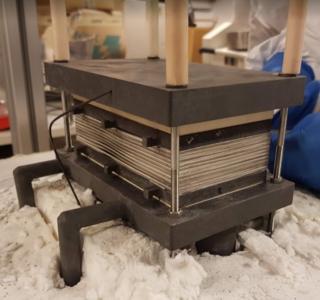High pressure water electrolyser development for exploration surface missions
Programme
TDE
Programme Reference
T322-602EP
Prime Contractor
PROTOTECH A.S.
Start Date
End Date
Status
Closed
Country
Norway

Objectives
Specify, design and build a breadboard prototype high-pressure electrolyser capable of creating hydrogen and oxygen from water manufactured in-situ in the Lunar or Martian environment
Description
Any manned exploration surface mission will rely on the availability of Oxygen for breathing, a power source that can operate independently of solar illumination and possibly, the ability to manufacture rocket propellant in-situ. All of these requirements can be met by the electrolysis of in-situ manufactured water. To achieve a highly reliable, light weight system, development of an electrolysis system that operates at high pressure is crucial.
For manned Mars missions, it is not viable to rely solely on the Oxygen that is taken to Mars from Earth because there is a continuous loss of it over time. This means, a source of fresh oxygen has to be made available for the astronauts. The presence of water has been confirmed in some areas on Mars. This water can be extracted and used by In Situ Resource Utilization (ISRU) as a resource for Oxygen. In order to extract oxygen from water, an electrolyser system is needed, this would also open up the possibility of storing excess H2/O2 fuel to be fed into a Fuel Cell power system. Further to this, on Lunar missions there is a possibility to manufacture H2/O2 Fuel cell Fuel or propellant from water that is created in-situ by the carbo-thermal reduction of regolith and methane reduction. This provides a supply of water that can then be electrolyzed to supply H2/O2 fuel for power generation or as propellant.
The electrolysis of water can be achieved by Proton Exchange Membrane based Electrolyser technology, which is readily available for terrestrial use. In order to keep the oxygen and hydrogen storage tanks compact and to avoid mechanical compressors with limited reliability, an electrolysis system that operates at high pressure with a pressure between 50 and 100 bar is preferable.
This activity encompasses the following tasks:
- Specification of system requirements for one (or more) typical operation cycles.
- Electrolyser system design study
- Management of Electrolyser electrodes poisoning by bi-products of Martian meltwater or carbo-thermal reduction.
- Breadboard of electrolyser system
- System shall be tested in terms of performance and durability.
- Roadmap report of the steps to take the system from TRL3 to TRL7.
Application Domain
Exploration
Technology Domain
22 - Environmental Control & Life Support (ECLS) and In Situ Resource Utilisation (ISRU)
3 - Space Systems Electrical Power
Competence Domain
4-Electric Architecture, Power and Energy, EMC
Keywords
3-In-Situ Resource Utilisation (ISRU)
Initial TRL
TRL 2
Target TRL
TRL 3
Achieved TRL
TRL 4
Public Document
Final Presentation
Executive Summary
